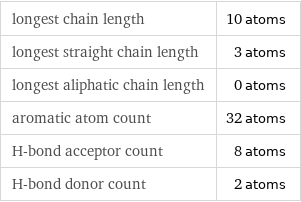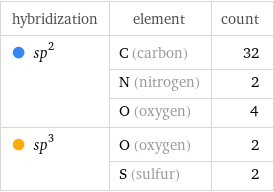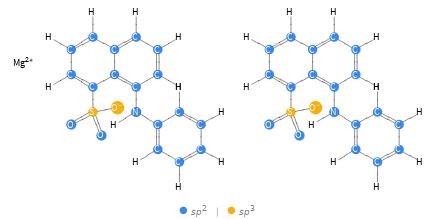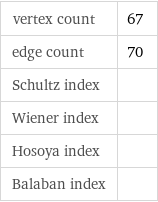Input interpretation

1-naphthalenesulfonic acid, 8-(phenylamino)-, magnesium salt (2:1)
Basic properties
![molar mass | 621 g/mol formula | C_32H_24MgN_2O_6S_2 empirical formula | Mg_C_32N_2S_2O_6H_24 SMILES identifier | C1=CC=C(C=C1)NC2=CC=CC3=C2C(=CC=C3)S(=O)(=O)[O-].C4=CC=C(C=C4)NC5=CC=CC6=C5C(=CC=C6)S(=O)(=O)[O-].[Mg+2] InChI identifier | InChI=1/2C16H13NO3S.Mg/c2*18-21(19, 20)15-11-5-7-12-6-4-10-14(16(12)15)17-13-8-2-1-3-9-13;/h2*1-11, 17H, (H, 18, 19, 20);/q;;+2/p-2/f2C16H12NO3S.Mg/q2*-1;m InChI key | IRKGXNAZPUOEMW-UHFFFAOYSA-L](../image_source/ddacf8922ac653778a77f366d8196831.png)
molar mass | 621 g/mol formula | C_32H_24MgN_2O_6S_2 empirical formula | Mg_C_32N_2S_2O_6H_24 SMILES identifier | C1=CC=C(C=C1)NC2=CC=CC3=C2C(=CC=C3)S(=O)(=O)[O-].C4=CC=C(C=C4)NC5=CC=CC6=C5C(=CC=C6)S(=O)(=O)[O-].[Mg+2] InChI identifier | InChI=1/2C16H13NO3S.Mg/c2*18-21(19, 20)15-11-5-7-12-6-4-10-14(16(12)15)17-13-8-2-1-3-9-13;/h2*1-11, 17H, (H, 18, 19, 20);/q;;+2/p-2/f2C16H12NO3S.Mg/q2*-1;m InChI key | IRKGXNAZPUOEMW-UHFFFAOYSA-L
Structure diagram

Structure diagram
Quantitative molecular descriptors

longest chain length | 10 atoms longest straight chain length | 3 atoms longest aliphatic chain length | 0 atoms aromatic atom count | 32 atoms H-bond acceptor count | 8 atoms H-bond donor count | 2 atoms
Elemental composition

Find the elemental composition for 1-naphthalenesulfonic acid, 8-(phenylamino)-, magnesium salt (2:1) in terms of the atom and mass percents: atom percent = N_i/N_atoms × 100% mass percent = (N_im_i)/m × 100% Plan: • Write the chemical formula and gather atomic masses from the periodic table. • Determine values for N_i, m_i, N_atoms and m using these items. • Finally, compute the percents and check the results. Write the chemical formula: C_32H_24MgN_2O_6S_2 Use the chemical formula to count the number of atoms, N_i, for each element and find the total number of atoms, N_atoms, per molecule: | number of atoms Mg (magnesium) | 1 C (carbon) | 32 N (nitrogen) | 2 S (sulfur) | 2 O (oxygen) | 6 H (hydrogen) | 24 N_atoms = 1 + 32 + 2 + 2 + 6 + 24 = 67 Divide each N_i by N_atoms to calculate atom fractions. Then use the property that atom fractions must sum to one to check the work: | number of atoms | atom fraction Mg (magnesium) | 1 | 1/67 C (carbon) | 32 | 32/67 N (nitrogen) | 2 | 2/67 S (sulfur) | 2 | 2/67 O (oxygen) | 6 | 6/67 H (hydrogen) | 24 | 24/67 Check: 1/67 + 32/67 + 2/67 + 2/67 + 6/67 + 24/67 = 1 Compute atom percents using the atom fractions: | number of atoms | atom percent Mg (magnesium) | 1 | 1/67 × 100% = 1.49% C (carbon) | 32 | 32/67 × 100% = 47.8% N (nitrogen) | 2 | 2/67 × 100% = 2.99% S (sulfur) | 2 | 2/67 × 100% = 2.99% O (oxygen) | 6 | 6/67 × 100% = 8.96% H (hydrogen) | 24 | 24/67 × 100% = 35.8% Look up the atomic mass, m_i, in unified atomic mass units, u, for each element in the periodic table: | number of atoms | atom percent | atomic mass/u Mg (magnesium) | 1 | 1.49% | 24.305 C (carbon) | 32 | 47.8% | 12.011 N (nitrogen) | 2 | 2.99% | 14.007 S (sulfur) | 2 | 2.99% | 32.06 O (oxygen) | 6 | 8.96% | 15.999 H (hydrogen) | 24 | 35.8% | 1.008 Multiply N_i by m_i to compute the mass for each element. Then sum those values to compute the molecular mass, m: | number of atoms | atom percent | atomic mass/u | mass/u Mg (magnesium) | 1 | 1.49% | 24.305 | 1 × 24.305 = 24.305 C (carbon) | 32 | 47.8% | 12.011 | 32 × 12.011 = 384.352 N (nitrogen) | 2 | 2.99% | 14.007 | 2 × 14.007 = 28.014 S (sulfur) | 2 | 2.99% | 32.06 | 2 × 32.06 = 64.12 O (oxygen) | 6 | 8.96% | 15.999 | 6 × 15.999 = 95.994 H (hydrogen) | 24 | 35.8% | 1.008 | 24 × 1.008 = 24.192 m = 24.305 u + 384.352 u + 28.014 u + 64.12 u + 95.994 u + 24.192 u = 620.977 u Divide the mass for each element by m to calculate mass fractions. Then use the property that mass fractions must sum to one to check the work: | number of atoms | atom percent | mass fraction Mg (magnesium) | 1 | 1.49% | 24.305/620.977 C (carbon) | 32 | 47.8% | 384.352/620.977 N (nitrogen) | 2 | 2.99% | 28.014/620.977 S (sulfur) | 2 | 2.99% | 64.12/620.977 O (oxygen) | 6 | 8.96% | 95.994/620.977 H (hydrogen) | 24 | 35.8% | 24.192/620.977 Check: 24.305/620.977 + 384.352/620.977 + 28.014/620.977 + 64.12/620.977 + 95.994/620.977 + 24.192/620.977 = 1 Compute mass percents using the mass fractions: Answer: | | | number of atoms | atom percent | mass percent Mg (magnesium) | 1 | 1.49% | 24.305/620.977 × 100% = 3.914% C (carbon) | 32 | 47.8% | 384.352/620.977 × 100% = 61.89% N (nitrogen) | 2 | 2.99% | 28.014/620.977 × 100% = 4.511% S (sulfur) | 2 | 2.99% | 64.12/620.977 × 100% = 10.33% O (oxygen) | 6 | 8.96% | 95.994/620.977 × 100% = 15.46% H (hydrogen) | 24 | 35.8% | 24.192/620.977 × 100% = 3.896%
Elemental oxidation states

The first step in finding the oxidation states (or oxidation numbers) in 1-naphthalenesulfonic acid, 8-(phenylamino)-, magnesium salt (2:1) is to draw the structure diagram. Next set every oxidation number equal to the atom's formal charge: In 1-naphthalenesulfonic acid, 8-(phenylamino)-, magnesium salt (2:1) hydrogen is not bonded to a metal with lower electronegativity, so it will have an oxidation state of +1. Any element bonded to hydrogen gains the bonding electrons, decreasing their oxidation state by 1 for every bond: With hydrogen out of the way, look at the remaining bonds. There are 4 carbon-nitrogen bonds, 2 carbon-sulfur bonds, 6 oxygen-sulfur bonds, and 34 carbon-carbon bonds. For each of these bonds, assign the bonding electrons to the most electronegative element. First examine the carbon-nitrogen bonds: element | electronegativity (Pauling scale) | C | 2.55 | N | 3.04 | | | Since nitrogen is more electronegative than carbon, the electrons in these bonds will go to nitrogen. Decrease the oxidation number for nitrogen in every highlighted bond (by 1 for single bonds, 2 for double bonds, and 3 for triple bonds), and increase the oxidation number for carbon accordingly: Next look at the carbon-sulfur bonds: element | electronegativity (Pauling scale) | C | 2.55 | S | 2.58 | | | Since sulfur is more electronegative than carbon, the electrons in these bonds will go to sulfur: Next look at the oxygen-sulfur bonds: element | electronegativity (Pauling scale) | O | 3.44 | S | 2.58 | | | Since oxygen is more electronegative than sulfur, the electrons in these bonds will go to oxygen: Next look at the carbon-carbon bonds: element | electronegativity (Pauling scale) | C | 2.55 | C | 2.55 | | | Since these elements are the same the bonding electrons are shared equally, and there is no change to the oxidation states: Now summarize the results: Answer: | | oxidation state | element | count -3 | N (nitrogen) | 2 -2 | O (oxygen) | 6 -1 | C (carbon) | 22 0 | C (carbon) | 4 +1 | C (carbon) | 6 | H (hydrogen) | 24 +2 | Mg (magnesium) | 1 +4 | S (sulfur) | 2
Orbital hybridization

hybridization | element | count sp^2 | C (carbon) | 32 | N (nitrogen) | 2 | O (oxygen) | 4 sp^3 | O (oxygen) | 2 | S (sulfur) | 2
Structure diagram

Orbital hybridization Structure diagram
Topological indices

vertex count | 67 edge count | 70 Schultz index | Wiener index | Hosoya index | Balaban index |